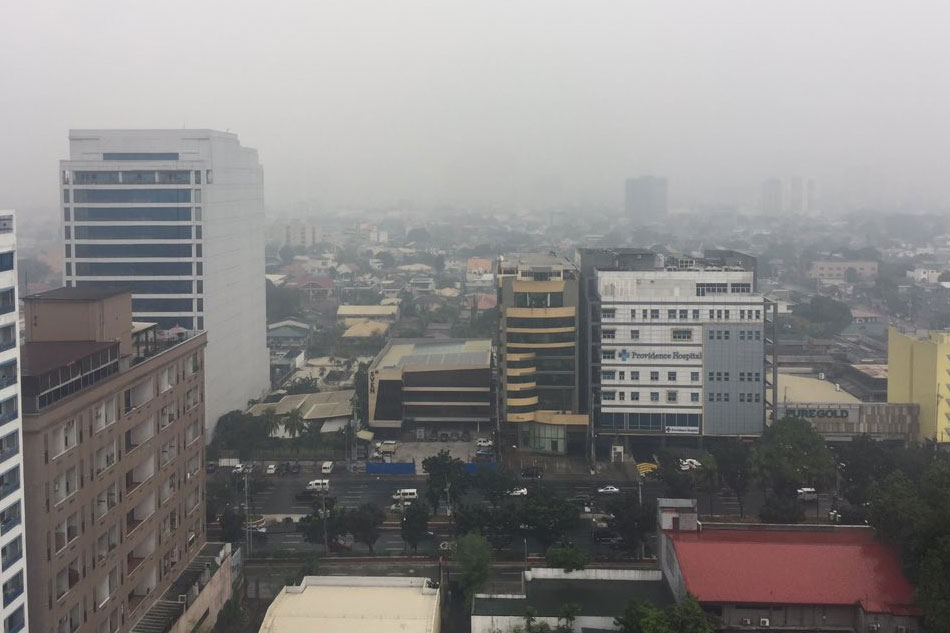Fog or haze in Metro Manila? Not connected to Taal Volcano but bad for health, says meteorologist | ABS-CBN
Fog or haze in Metro Manila? Not connected to Taal Volcano but bad for health, says meteorologist
Fog or haze in Metro Manila? Not connected to Taal Volcano but bad for health, says meteorologist
Kristine Sabillo,
ABS-CBN News
Published Jan 24, 2020 04:49 PM PHT
|
Updated Jan 24, 2020 05:07 PM PHT
MANILA - If you’ve noticed the foggy-like haze seen around Metro Manila on Friday, it’s not fog or ash from Taal Volcano, a meteorologist said.
MANILA - If you’ve noticed the foggy-like haze seen around Metro Manila on Friday, it’s not fog or ash from Taal Volcano, a meteorologist said.
“It has nothing to do with Taal (Volcano). It’s not fog either,” said UP Institute of Environmental Science and Meteorology (IESM) professor Dr. Gerry Bagtasa in a text message to ABS-CBN News.
“It has nothing to do with Taal (Volcano). It’s not fog either,” said UP Institute of Environmental Science and Meteorology (IESM) professor Dr. Gerry Bagtasa in a text message to ABS-CBN News.
“Air is currently stagnant because of opposing winds over Metro Manila. High humidity or light rain gives it the appearance of fog,” he further said.
“Air is currently stagnant because of opposing winds over Metro Manila. High humidity or light rain gives it the appearance of fog,” he further said.
Air quality monitoring site Airtoday recorded “poor” air quality on Friday afternoon, with the level or air pollutants reaching 63 to 65 micrograms per cubic meter by 1 p.m. The World Health Organization standard for exposure to air pollution is at a maximum of 25 micrograms per cubic meter.
Air quality monitoring site Airtoday recorded “poor” air quality on Friday afternoon, with the level or air pollutants reaching 63 to 65 micrograms per cubic meter by 1 p.m. The World Health Organization standard for exposure to air pollution is at a maximum of 25 micrograms per cubic meter.
ADVERTISEMENT
Air Intellipure also posted in its Facebook page that their monitoring measured 14.6 million particles per cubic foot in Makati.
“Air particle levels are the highest we have ever seen.”
Air Intellipure also posted in its Facebook page that their monitoring measured 14.6 million particles per cubic foot in Makati.
“Air particle levels are the highest we have ever seen.”
BAD FOR HEALTH
Bagtasa said with the high level of pollutants in the air, people should “refrain from outdoor activities and stay indoors” because it is bad for their health.
Bagtasa said with the high level of pollutants in the air, people should “refrain from outdoor activities and stay indoors” because it is bad for their health.
He said this has happened before because of the weather.
He said this has happened before because of the weather.
With the level or air pollutants reaching 63 to 65 micrograms per cubic meter, air quality is poor (WHO standard for exposure to air pollution is at a maximum of 25 micrograms per cubic meter). Prof. Bagtasa @Weather_Manila says people should stay indoors. @ABSCBNNews pic.twitter.com/VOqupQ9758
— Kristine Sabillo (@kristinesabillo) January 24, 2020
With the level or air pollutants reaching 63 to 65 micrograms per cubic meter, air quality is poor (WHO standard for exposure to air pollution is at a maximum of 25 micrograms per cubic meter). Prof. Bagtasa @Weather_Manila says people should stay indoors. @ABSCBNNews pic.twitter.com/VOqupQ9758
— Kristine Sabillo (@kristinesabillo) January 24, 2020
Philippine Institute of Volcanology and Seismology’s (Phivolcs) Mariton Bornas, who heads the agency’s Volcano Monitoring and Eruption Prediction Division, said in a comment to reporters that it’s also hard to tell if it’s linked to volcanic ash.
Philippine Institute of Volcanology and Seismology’s (Phivolcs) Mariton Bornas, who heads the agency’s Volcano Monitoring and Eruption Prediction Division, said in a comment to reporters that it’s also hard to tell if it’s linked to volcanic ash.
“We had a brief minor ash emission period today, plus there seems to be rain,” she wrote. “Fine ash can remain in suspension in the atmosphere for three days. But this haze could also be just pollution.”
“We had a brief minor ash emission period today, plus there seems to be rain,” she wrote. “Fine ash can remain in suspension in the atmosphere for three days. But this haze could also be just pollution.”
Bornas also told ABS-CBN News that meteorologists are getting more information.
Bornas also told ABS-CBN News that meteorologists are getting more information.
In a Twitter thread, Bagtasa said pollutants are unable to disperse due to the prevailing winds and the temperature.
In a Twitter thread, Bagtasa said pollutants are unable to disperse due to the prevailing winds and the temperature.
“Is that fog? NO, high humidity (there's drizzle) results in particulates being coated with water, which further reduces visibility. This gives the appearance of fog,” he further explained.
“Is that fog? NO, high humidity (there's drizzle) results in particulates being coated with water, which further reduces visibility. This gives the appearance of fog,” he further explained.
3) is that fog? NO, high humidity (there's drizzle) results in particulates being coated with water, which further reduces visibility. This gives the appearance of fog. This property of particulates called hygroscopicity is one of the topics of my dissertation/2007 paper pic.twitter.com/Gh7EGKdoeb
— WeatherManila (@Weather_Manila) January 24, 2020
3) is that fog? NO, high humidity (there's drizzle) results in particulates being coated with water, which further reduces visibility. This gives the appearance of fog. This property of particulates called hygroscopicity is one of the topics of my dissertation/2007 paper pic.twitter.com/Gh7EGKdoeb
— WeatherManila (@Weather_Manila) January 24, 2020
ADVERTISEMENT
ADVERTISEMENT

